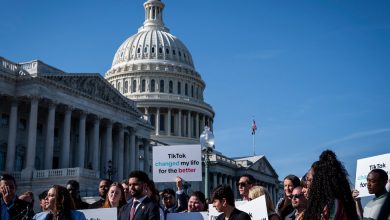Amid Push to Vaccinate Children, Other Challenges Deluge Pediatricians

CHARLOTTE, N.C. — Near the end of one of the first days that 5- to 11-year-olds could get a coronavirus shot last month, Dr. Anne Steptoe, a pediatrician, sat hunched in her cramped office between packages of diapers, onesies and children’s books, cataloging the week’s patients on her laptop.
One teenage girl had been sleepless and suicidal; another was anemic. Several young boys had gained weight during the pandemic. A 10-year-old had been plagued by asthma attacks and was using her inhalers incorrectly. Another child of the same age needed a mental health consultation after angry outbursts at school.
The rollout of the shot for young children brought relief for many families eager to shore up protection amid a wave of new virus cases. But much of the upfront demand has already been met; many parents who were eager to get their children vaccinated have done so. The success of the campaign, made even more urgent with the arrival of the Omicron variant, depends on the next phase: reaching the hesitant and undecided, including those who have not given thought or gained access to the shot.
Dr. Steptoe’s patients at Charlotte Community Health Clinic, many of whom have chronic medical conditions, crowded housing arrangements and vulnerable family members, are among the children most in need of the shot. Yet most parents who have brought their children to the clinic over the past month have declined it. They are wary of the vaccine, focused on getting treatment for mental and physical problems that had gone unchecked for much of the pandemic.
More broadly, Dr. Steptoe said, her patients and their families were taking a cautious, “stepwise” approach, seeing how that shot was deployed among friends and neighbors, and asking for follow-up conversations with the clinic. That was also the case in the adolescent vaccination campaign, she said, leading to steadier uptake months into the shot’s deployment in that age group.
For now, the numbers are meager. A pediatric vaccine kickoff event at the clinic drew just six children despite being advertised locally. Only 43 of the 900 doses the clinic received have been used as of Tuesday, and just 18 percent of 5- to 11-year-olds in Mecklenburg County, which includes Charlotte, had received an initial dose as of Nov. 29, said Dr. Raynard Washington, the county’s deputy public health director.
While the Biden administration has paid special attention to getting the vaccine to pediatricians in private practice, it has also helped steer hundreds of thousands of doses to community health clinics like Dr. Steptoe’s.
In 2020, 80 percent of Dr. Steptoe’s clinic’s nearly 5,000 patients were uninsured, including 70 percent of children. For them, it is one of the few local access points for health care in a fast-growing city.
Already, Dr. Steptoe has seen the extremes of the pandemic’s effects on children’s well-being, including their mental health — the subject of a report published Tuesday by Dr. Vivek H. Murthy, the surgeon general.
Josue, a 15-year-old from Honduras who had recently spent about six weeks in a hospital for malnutrition and blood count abnormalities, likely had undiagnosed cystic fibrosis, Dr. Steptoe decided after examining him.
She reviewed with Josue and his sister a list of specialists he would need to see: a pulmonologist, geneticist, gastroenterologist, kidney doctor, endocrinologist and infectious disease expert. He was uninsured, and already facing what his sister said was a $2,800 hospital bill plus significant prescription drug costs, which Dr. Steptoe said a federal program could help cover.
Josue had gotten his first coronavirus shot in early September, but was hospitalized before he was eligible for a second dose and had delayed it. For many patients seen at the clinic in the opening days of the children’s vaccine rollout — and their parents — the simple act of sitting in a physician’s office for the first time at least since the pandemic began forced a reckoning with vaccine hesitancy.
“It’s building a plane in flight,” Carolyn Allison, the clinic’s chief executive, said of its efforts to get children vaccinated. “It may not be anti-vaccine, but ‘What is practical in my universe?’”
Dr. Steptoe said she is careful to acknowledge a family’s fears about the Covid-19 vaccine without challenging them.
“What I’ve learned through the pandemic is just to keep having conversations and listening to people, because I do hear different things over time,” she said. Counseling families on the vaccine would be a “long-term game,” she said.
Nationwide, five million of the 28 million children in the 5-to-11 age group, or roughly 18 percent, have received at least one dose of the Pfizer-BioNTech vaccine since it became available to them more than a month ago, a figure that suggests the campaign will require gradual progress.
For the few young patients who did receive the Covid-19 vaccine at the clinic the first week they were eligible, families often made significant sacrifices to get them there. Emiliano, a 9-year old with attention deficit hyperactivity disorder who came for a physical, had recently lashed out several times at school. A clinic social worker discussed anger management with him. His father had taken a day off from work, and his mother three hours off, to get him there.
But Emiliano eagerly agreed to the vaccine — prompting tears of relief from his mother, who had played him videos of other children getting it to encourage him.
A patient’s view of the vaccine at any given appointment, Dr. Steptoe said, was a “snapshot in time.”
Getting to a second conversation, or a third, increased her odds of a parent and child eventually choosing the vaccine.
“Even for people that I know I have no shot of getting a shot into an arm that day,” she added. “It’s another voice, hopefully that they trust, or are building trust with, that says that in a calm and confident way and without any judgment.”
Dr. Steptoe grew up in rural West Virginia without adequate primary care, she said, forcing her family to travel across state lines for routine checkups. She almost died after a botched tonsillectomy in elementary school — the surgeon did not properly close a wound — an experience that inspired her interest in pediatrics.
“I knew from an early age that bad things happened to people in health care,” she said. “That was linked to the resources that we had in our community.”
For many young patients, she said, the pandemic had sharpened conflicts within their families that had saddled them with mental health problems. As a screening question, she often asks patients whether they can count on the adults in their lives.
The Coronavirus Pandemic: Key Things to Know
The Omicron variant. The latest Covid-19 variant has been detected in dozens of countries, including the U.S. It seems to spread rapidly, but it may be less severe than other forms of the virus. As experts race to learn more, here’s a look at four big questions about Omicron and what we know so far.
Travel restrictions and lockdowns. The U.S. is requiring international travelers to provide proof of a negative test taken no more than a day before their flights. In Europe, where Germany has already announced tough restrictions on unvaccinated people, worries of new lockdowns loom.
New York City’s new mandate. Mayor Bill de Blasio announced a sweeping vaccine mandate for all private employers in New York City to combat the spread of the Omicron variant. It is unclear if the incoming mayor, Eric Adams, intends to enforce the mandate.
New Covid treatments. Two Covid-19 pills, by Merck and Pfizer, should be available soon. These new treatment options may be just the beginning: Scientists say we will need an arsenal of drugs to deploy against new variants — especially if those foes erode the protection of existing vaccines.
The practice has sought out foster care children, many of whom have experienced neglect in part because of a spiraling addiction problem in the state, made worse by the pandemic.
Even those with supportive families have often gone years without seeing a doctor. Andi, a 10-year-old boy seen at the clinic, was a rare “yes” for vaccination; his grandmother was eager to have him protected in school. Separately, though, Dr. Steptoe noticed a severe cavity eating away at a tooth, which required an urgent dental referral. The clinic’s dental practice is facing a deluge of patients, with a long wait list.
A few hours later, Brandon, 10, carefully watched his older brother, Jonathan, get several vaccines, including the Covid-19 shot. He decided to get the shot, too, drawing applause.
But nearby, the mother of Eliuth, 10, and Karen, 13, refused the vaccine for them, saying that family members had died after getting the shot. Bria Clyburn, a medical assistant, was careful not to sound dismissive, gently telling them that they had long lives ahead and needed to be protected for the holidays. Their mother promised to consider allowing them to get vaccinated at their next appointment, months away.
Promotion of the vaccine was often wedged into anguished discussions about how a child’s social life had been shattered by the virus. Away from school, her patients who badly needed intellectual and social stimulation had suffered developmental problems, Dr. Steptoe said. If she detects mental health problems during an appointment, she summons Rachael Pennell, a behavioral health consultant.
Emiliano, the 9-year-old patient who had recently erupted at students and teachers in school, was grounded after disrupting class. Ms. Pennell told his parents to let him keep going to soccer practice.
The pandemic had deprived children of “two years of key relationships,” she said.
Dr. Steptoe said that the father of one young child she saw recently was fearful of letting his son even go outside during the pandemic, lest he bring the virus home to vulnerable family members. The child gained 40 pounds in a year.
Dylan, an 8-year-old patient, had gained weight during the pandemic but was beginning to get more exercise. Dr. Steptoe suggested strategies for keeping junk food out of the home. But when the discussion turned to the Covid vaccine, Dylan’s mother said she would need to consult her husband.
Late one day, Dr. Steptoe greeted 16-year-old Tiffany, who after moving to Charlotte during the pandemic had gone months without the medication she needed to treat several mental health disorders. She was struggling to sleep. School officials had appeared at her home one day after she missed a significant amount of class. She was fearful that if she returned to school, she would be confronted there about her problems and judged by her peers.
Dr. Steptoe talked to her about the possibility of taking community college classes online or switching to temporary home-schooling.
Tiffany said she dreamed of becoming a school guidance counselor, to help children with similar troubles.
Gently, the doctor steered toward the topic of the Covid vaccine. Her mother was against it, saying she did not want to be a guinea pig for the government. But she allowed Tiffany to make her own decision.
Tiffany questioned why she should get the shot if she would still have to wear a mask. She was nervous, she added, about the risk of heart-related side effects.
“I just want to get your questions answered,” Dr. Steptoe said, explaining the shot’s benefits.
She decided not to push any further.



